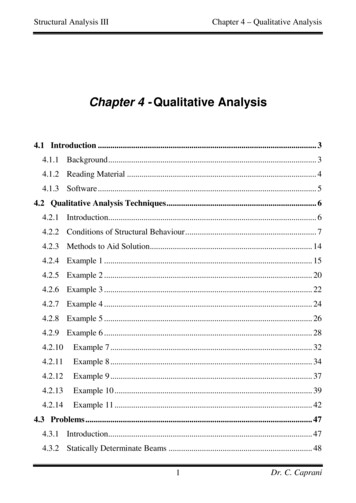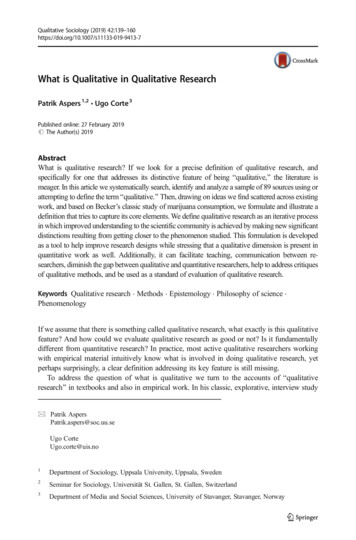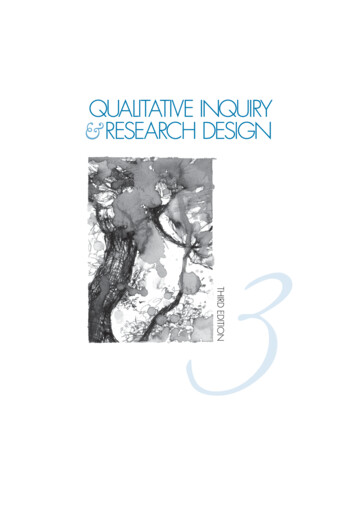
Transcription
Structural Analysis IIIChapter 4 – Qualitative AnalysisChapter 4 - Qualitative Analysis4.1 Introduction . 34.1.1 Background . 34.1.2 Reading Material . 44.1.3 Software . 54.2 Qualitative Analysis Techniques . 64.2.1 Introduction. 64.2.2 Conditions of Structural Behaviour . 74.2.3 Methods to Aid Solution. 144.2.4 Example 1 . 154.2.5 Example 2 . 204.2.6 Example 3 . 224.2.7 Example 4 . 244.2.8 Example 5 . 264.2.9 Example 6 . 284.2.10Example 7 . 324.2.11Example 8 . 344.2.12Example 9 . 374.2.13Example 10 . 394.2.14Example 11 . 424.3 Problems . 474.3.1 Introduction. 474.3.2 Statically Determinate Beams . 481Dr. C. Caprani
Structural Analysis IIIChapter 4 – Qualitative Analysis4.3.3 Statically Determinate Frames. 504.3.4 Statically Indeterminate Beams . 564.3.5 Statically Indeterminate Frames . 584.3.6 Trusses . 64Rev. 12Dr. C. Caprani
Structural Analysis IIIChapter 4 – Qualitative Analysis4.1 Introduction4.1.1 BackgroundThe ability to ‘see’ and interpret structural behaviour is a core ability of a structuralengineer. At the initial stage of a structural scheme design, we are not interested innumbers, or amounts, only the sense of a load effect. Some examples of what wemean by sense are: Is there tension on the top or bottom of a beam? Does the tip of a cantilever deflect up or down? Is the moment reaction clockwise or anti-clockwise?Getting this level of analysis right is not only the first step, but the most importantstep. If we don’t get this level right, then the answers to a more complicated analysiswill be meaningless.The ability to get the right answers to this level is called Structural Intuition. Thebetter your structural intuition, the better you will be a designer. This ability reduceserrors both in design practice but also whilst in college: since you will already ‘see’the answer it is easier to catch errors in calculations.3Dr. C. Caprani
Structural Analysis IIIChapter 4 – Qualitative Analysis4.1.2 Reading MaterialSome good books on structural behaviour are: Brohn, D., Understanding Structural Analysis, 4th Edn., New ParadigmSolutions, 2005. Jennings, A., Structures: from theory to practice, Spon Press, 2004. Ji, T., and Bell, A., Seeing and Touching Structural Concepts, Taylor & Francis,2008. Hilson, B., Basic Structural Behaviour: Understanding Structures from Models,Thomas Telford, 1993. Pippard, A.J.S., The Experimental Study of Structures, Edward Arnold & Co.,London, 1947. I.Struct.E., Qualitative Analysis of Structures, London, 1989.Due to its importance, the Ove Arup Foundation sponsored the report: The Teachingof Structural Analysis by Prof. Ian May and Dr. David Johnson. It is accessible siswithCover.pdf.A summarized version of the report appeared in The Structural Engineer, Vol.81,No.7, 2003, p.33-37, available at this /Abstract.asp?PID 79044Dr. C. Caprani
Structural Analysis IIIChapter 4 – Qualitative Analysis4.1.3 SoftwareIn developing your structural intuition, it is very helpful to model structures using aappropriate computer program – especially when the structure behaves counterintuitively. Most structural analysis programs today are extremely complex withmany options and capabilities and this can often obscure the modelling process.An appropriate program (for a few reasons) is LinPro – freely available fromwww.line.co.ba. You should install LinPro on your own computer. Also, it isinstalled on the computers in Rm 392.The program is intuitive to use and comes with a reasonable help file. If you have anydifficulties using the program, please ask the lecturer.Another program for the analysis of trusses is TrussMaster, developed by the lecturerfor the purposes of teaching structural behaviour of trusses. This is available on thecollege computers, and a User Manual is also available at www.colincaprani.com.5Dr. C. Caprani
Structural Analysis IIIChapter 4 – Qualitative Analysis4.2 Qualitative Analysis Techniques4.2.1 IntroductionQualitative Analysis is not a linear process. For some problems we might start withreactions and proceed through bending moments to a displaced shape, whilst forothers we may begin with a displaced shape, work out reactions, and then find thebending moment diagram. The approach to use will depend on the problem and thereare set rules or procedures that you can follow to be guaranteed to arrive at thecorrect solution.On a more positive note, since the structure will only behave in one distinct manner,there can only be one correct solution. By definition therefore, incorrect solutionswill contain inherent incompatibilities. For example, all aspects of a frame’s solutionmay agree (e.g. reactions, bending moment diagram, etc.), but it may require a rigidjoint to have different rotations. Since this is impossible, we know that this cannot bethe right answer. Therefore if we have a proposed solution, we must ensure that itdoes not violate any of the conditions of structural behaviour. If it does, then it is notthe correct solution. In other words, your answer will tell you if it is wrong or not!6Dr. C. Caprani
Structural Analysis IIIChapter 4 – Qualitative Analysis4.2.2 Conditions of Structural BehaviourThere are certainties about structural behaviour that we can rely on when attemptingto analyse a structure. Most of these are plainly obvious, but a few may not be.1.Remember the very basics: moment force distance.2.Know your support types and the type of restraint they ertical RollerδXδY θPinδXδYθFixedδXδYθVertical Support(beam continuous over thesupport and can rotate)δXδYθ7θDr. C. Caprani
Structural Analysis III3.Chapter 4 – Qualitative AnalysisRecall the shapes of BMD and SFD under the different types of loading(rectangular, triangular, parabolic).4.Remember: shear is rate of change of moment.5.No transverse load or end shear force on a frame member means there isconstant BM along the member (constant may equal zero).6.There is zero bending moment at a hinge.8Dr. C. Caprani
Structural Analysis III7.Chapter 4 – Qualitative AnalysisMembers with no bending moments remain straight (i.e. no bending), but maystill move.8.Always draw the bending moment diagram on the tension face of the member.to be consistent with our convention9.Remember, fixed supports will have a moment reaction, pinned supports willnot, though there may be an external moment applied at a pinned support.10. For unbraced frames, only symmetrical such frames symmetrically loaded willnot sway.11. Keep in mind: deflections are always small and we neglect the self weight of thestructures – only analyse for the loads shown.12. Deflected shapes are always very smooth curves, except at a hinge.13. Rigid joints in frames must keep the same angle as they rotate.9Dr. C. Caprani
Structural Analysis IIIChapter 4 – Qualitative Analysis14. Rigid joints can only open or close:OpenClose15. At a rigid joint with two members, there is only one value of moment (Mabove). (There is one rare exception to this rule)16. At a right-angle rigid joint, the shear becomes the axial and the axial becomesthe shear in the alternate members. Just use10 FX 0 and FY 0 to see why.Dr. C. Caprani
Structural Analysis IIIChapter 4 – Qualitative Analysis17. This is not the case for oblique-angle joints:18. When more than two members meet at a rigid joint, the joint must be inM B M C . A furtherequilibrium. This means that for the joint below, M Aimplication of this is seen in the BMD: there is a step in the bending moment formember AB at the joint of value M MA MB .C11Dr. C. Caprani
Structural Analysis IIIChapter 4 – Qualitative Analysis19. For frames, we normally neglect axial deformation. This means that memberscannot change length and because deflections are small, this means that themember’s joints must move perpendicular to the line of the member. Forexample, below B can only move along the line BB’.20. Trusses do not have bending moment diagrams.21. Remember the axial force sign convention:TensionCompressionNo axial force12Dr. C. Caprani
Structural Analysis IIIChapter 4 – Qualitative Analysis22. Positive shear force sign convention makes the letter ‘N’: up on the left, downon the right:13Dr. C. Caprani
Structural Analysis IIIChapter 4 – Qualitative Analysis4.2.3 Methods to Aid SolutionThe following are some methods that may help you carry out the analyses:1.To find a support reaction, Remove the Restraint offered by the reaction anddraw the deflected shape of the resulting structure. Apply the support reaction insuch to as to bring the structure back to where it should be.2.Use Points of Certainty – where you know the deflected position, for example ata support the deflection is zero, and usually the structure moves away from theapplied load (though there are rare exceptions).3.For more complex structures, remove excess members/supports/joints andreintroduce one at a time and observe the effect each additional feature has.14Dr. C. Caprani
Structural Analysis IIIChapter 4 – Qualitative Analysis4.2.4 Example 1ProblemAnalyse the following beam for the reactions, bending moment and shear forcediagrams, and draw the deflected shape.SolutionFirstly we identify the Points of Certainty: It cannot move horizontally or vertically at A; It cannot move vertically at B; It will probably move downwards at C away from the load.This gives the following points through which the deflected shape must pass:Noting that the deflected shape is always a smooth curve (except at hinges, of whichthere are none here), we join the three points with a smooth curve:15Dr. C. Caprani
Structural Analysis IIIChapter 4 – Qualitative AnalysisAlso, we know there is tension (“T” above) on the outside of the curve and so weinclude this in our drawing. This helps inform us of the bending moment diagram –always draw it on the tension face.To find the direction of the reactions, we will remove each restraint in turn andfollow the above steps to see how the beam deflects when the restraint is removed. For HA:Since there is no movement of the beam when HA is released, H A 0 . For VA:16Dr. C. Caprani
Structural Analysis IIIChapter 4 – Qualitative AnalysisSince when VA is removed it moves upwards, it must be that VA acts downwards inthe actual structure to keep the beam at A where it must remain. For VB:Since when VB is removed the beam moves downwards, VB acts upwards in the actualstructure to ensure that B remains where it should.Thus the reactions are:With this information is now becomes easier to establish the bending moment andshear force diagrams. Starting with the bending moment diagram for the portion ABof the beam, we take a cut somewhere to the right of A:17Dr. C. Caprani
Structural Analysis IIIChapter 4 – Qualitative AnalysisAs may be seen, the effect of VA is to cause an anti-clockwise rotation of the segmentwhich must therefore be resisted by a clockwise internal bending moment MX, asshown. This means (since the arrow comes from the tension face) that tension is onthe top of the beam, and is increasing as the distance increases (the force remainingconstant).Similarly, we examine the portion BC:18Dr. C. Caprani
Structural Analysis IIIChapter 4 – Qualitative AnalysisThere are no applied moments, so the bending moment diagram does not have anysteps in it. This means that the two portions that we have identified above must meetover B to give:The shear force diagram is easy to construct by just following the forces: moving leftto right it is down at A then up at B over the line to a height equal to the applied force.The total height at B is the vertical reaction at B and this must sum to the totaldownward forces at A and C:Note also that since V dM dx , we see that the negative shear corresponds to anegative slope in the BMD19Dr. C. Caprani
Structural Analysis IIIChapter 4 – Qualitative Analysis4.2.5 Example 2ProblemAnalyse the following beam for the reactions, bending moment and shear forcediagrams, and draw the deflected shape.SolutionUsing the same techniques as outlined in Example 1, we can quickly arrive at thedeflected shape and reactions:Based on the reactions, we can then examine the two portions of the structure forbending moments: AC: For this portion, the moment comes mainly from the reaction VA. However,the moment gets progressively smaller than it would have been if just VA wasacting (i.e. force distance) since the UDL acts in the opposite direction. Thismeans the BMD curves as shown below. CB: This portion is as studied in Example 1 is found from force distance.20Dr. C. Caprani
Structural Analysis IIIChapter 4 – Qualitative AnalysisAgain, just like in Example 1, we recognize that we have no steps in the BMD and sojoin the moment diagrams for the two portions at C to get:The shear force diagram is explained in the diagram:21Dr. C. Caprani
Structural Analysis IIIChapter 4 – Qualitative Analysis4.2.6 Example 3ProblemAnalyse the following beam for the reactions, bending moment and shear forcediagrams, and draw the deflected shape.SolutionAgain applying the techniques of Example 1 give the following deflected shape andreactions:Note that for portion BC we recognize that there is no bending of the member.However, this does no mean that the member does not move: it does, and keeps astraight line extending the tangent to the deflected curve just to the left of B.The bending moment and shear force diagrams are then found as per Example 2:22Dr. C. Caprani
Structural Analysis IIIChapter 4 – Qualitative Analysis23Dr. C. Caprani
Structural Analysis IIIChapter 4 – Qualitative Analysis4.2.7 Example 4ProblemAnalyse the following beam for the reactions, bending moment and shear forcediagrams, and draw the deflected shape.SolutionAgain using points of certainty and removal of restraints we arrive at:This allows us to look at the two portions of the structure for the BMD: AB: For this portion, we recognize that we have an increasing force (due to theaccumulation of load form the UDL) as the distance increases. Thus we have adoubly increasing moment as the distance changes and so the BMD curvesupwards as shown. BC: For this section, just apply force distance.24Dr. C. Caprani
Structural Analysis IIIChapter 4 – Qualitative AnalysisThe BMD must not step (no applied moment) and so joins at B to yield:And the shear force diagram follows, either form the load types, or by looking at theBMD (curve to slope, line to constant).25Dr. C. Caprani
Structural Analysis IIIChapter 4 – Qualitative Analysis4.2.8 Example 5ProblemAnalyse the following frame for the reactions, bending moment, shear, and axialforce diagrams, and draw the deflected shape.SolutionFor this frame, we will start by establishing the reactions. First, since there is no26Dr. C. Caprani
Structural Analysis IIIChapter 4 – Qualitative Analysis27Dr. C. Caprani
Structural Analysis IIIChapter 4 – Qualitative Analysis4.2.9 Example 6ProblemAnalyse the following frame for the reactions, bending moment, shear, and axialforce diagrams, and draw the deflected shape.SolutionTo begin, we will determine the direction of the vertical reaction at C. As ever, to dothis, we will remove the restraint and examine what happens ot the structure underthe applied load:28Dr. C. Caprani
Structural Analysis IIIChapter 4 – Qualitative AnalysisGiven this deflected shape, it is obvious that the vertical reaction at C should beupwards to keep C at the correct height. Since there are no vertical loads, this meansthat because of FY 0 , we must have VA acting downwards. Since there is noother possible horizontal force, by FX 0 we have H A acting to the left. Thus wehave:In the above diagram we have also indicated some points of certainty. That of A iseasy due to the support. However, at B we note that the frame should move awayfrom the load, but cannot move vertically downwards since member AB does notchange length (ignoring axial deformation). This locates the deflected position ofjoint B. And, as indicated in the diagram, once the deflected location of joint B isknown, so is that of joint C, because we know that member BC does not changelength. Finally then, to assist us drawing the deflected shape between these points ofcertainty, we recognize that the joint is opening and so is rotating clockwise to give:29Dr. C. Caprani
Structural Analysis IIIChapter 4 – Qualitative AnalysisIn the above, the tangents to the deflected shape curves are shown at joint B todemonstrate that the joint is rotating, but keeping its angle the same at B.The BMD is easily established considering free-body diagrams of each member,along with the simple force distance:Recalling that shear is transverse forces to the member line, in considering the shearof member AB, we need only consider the applied load and H A to get:30Dr. C. Caprani
Structural Analysis IIIChapter 4 – Qualitative AnalysisFor the shear in member BC, we must first consider that the transverse force (besidesVC ) gets there through member AB as an axial force (caused by VA ), to get:We combine the two solutions above to get the final shear and axial force diagrams:31Dr. C. Caprani
Structural Analysis IIIChapter 4 – Qualitative Analysis4.2.10 Example 7ProblemAnalyse the following frame for the reactions, bending moment, shear, and axialforce diagrams, and draw the deflected shape.SolutionThis frame is the same as that of Example 6, except for the support type at A. Thuswe will see the influence of fixing a support on a structure. Firstly, proceed as we didbefore, and remove the support at C to get:32Dr. C. Caprani
Structural Analysis IIIChapter 4 – Qualitative AnalysisNotice that the diagram emphasises that the horizontal displacements at B and C mustbe the same since member BC does not change length. Also we see that we developan anti-clockwise moment reaction at A.Next, introduce the vertical support at C, noting that we now have an upwardsvertical reaction at C, and proceed as before to get:Notice that the Point of Contraflexure is noted as a dot in the deflected shapedrawing, and its location is produced across to locate the zero point of bendingmoment on the column AB.The shear force and axial force diagrams are obtained as was done in Example 6:33Dr. C. Caprani
Structural Analysis IIIChapter 4 – Qualitative Analysis4.2.11 Example 8ProblemAnalyse the following frame for the reactions, bending moment, shear, and axialforce diagrams, and draw the deflected shape.SolutionFor this frame, we will start by establishing the reactions. First, since there is nohorizontal support at D, and since FX 0 , we know H A 0 . Also by consideringremoval of restraints we will see that the two vertical reactions are upwards, to give:34Dr. C. Caprani
Structural Analysis IIIChapter 4 – Qualitative AnalysisBending moments are only caused by forces transverse to a member. Thus, with nohorizontal reactions (i.e. no forces transverse to members AB or CD), there can be nobending moments in the columns. This only leaves the beam BC to act as a simplysupported beam, giving the BMD as:Next we note that the columns are in compression (by the reactions) and transmit theend shears of member BC to ground, whilst there is no axial force in the beam sincethere are no horizontal forces. The shear force and axial force diagrams are thus:Lastly, we come to draw the deflected shape of this frame. However, before we do so,we recall that there is no bending in the columns and that member BC behaves as if asimply-supported beam. We examine the bending of member BC in more detail:35Dr. C. Caprani
Structural Analysis IIIChapter 4 – Qualitative AnalysisIn this diagram we have identified the tangents to the end rotations of beam BC andthe perpendiculars to these tangents. We recall that the right-angle rigid joints of theframe remain at right-angles, and so joints B and C of the frame rotate through θ .However, since there is no bending in member AB, and since A cannot move (pinsupport), B must move to B’ so that the rotation θ can occur at B. Joint C andmember CD behave similarly. Finally, we note that the distance BB’ and CC’ must bethe same since member BC does not change length. All of this gives:A way to think about it is that the frame sways to the right in order to avoid bendingthe columns.36Dr. C. Caprani
Structural Analysis IIIChapter 4 – Qualitative Analysis4.2.12 Example 9ProblemAnalyse the following frame for the reactions, bending moment, shear, and axialforce diagrams, and draw the deflected shape.SolutionThis frame is quite similar to the previous frame, except that D cannot movehorizontally. This being the case, we must have a horizontal reaction acting to the leftat D. Further, since FX 0 we must have a horizontal reaction at A opposing H D .Please note this as it is a common misconception:Just because there are no applied horizontal forces, does not mean therecannot be any horizontal reactions (but if there are, they must balance).Finally for the reactions then, we note that the vertical supports must offer upwardsreactions. Thus our deflected shape and reactions are:37Dr. C. Caprani
Structural Analysis IIIChapter 4 – Qualitative AnalysisThe BMD, SFD, and AFD follow directly by applying the techniques covered earliergiven the reactions. Note especially that joints B and C are effectively closing andthat beam BC behaves similar to a fixed-fixed beam:38Dr. C. Caprani
Structural Analysis IIIChapter 4 – Qualitative Analysis4.2.13 Example 10ProblemAnalyse the following frame for the reactions, bending moment, shear, and axialforce diagrams, and draw the deflected shape.SolutionTo proceed with this frame we will split it at the hinge:39Dr. C. Caprani
Structural Analysis IIIChapter 4 – Qualitative AnalysisWe note then that CD is effectively a simply supported beam, and this gives theinteraction force direction as upwards for CD (reflecting the support that the structureABC offers) and downwards for ABC (reflecting the push coming from the load onthe beam). From VCB we can determine the moment and vertical reactions at A.The deflection behaviour of the beam CD is straightforward. We examine thedeflection behaviour of ABC noting that B moves away from the load (downwards)and member BC maintains the perpendicular angle to the tangent at B. Moreover,member BC has not transverse force as so remains straight (i.e. does not bend).Lastly, see that the vertical movement of joints B and C must be the same sincemember BC does not change length:To obtain the overall deflected shape, add the above to that of the beam CD to get:40Dr. C. Caprani
Structural Analysis IIIChapter 4 – Qualitative AnalysisThe diagram emphasises the point that the horizontal movement at C and D must beequal since the beam CD does not change length.With the reactions and deflected shape established, the remaining diagrams followeasily using the techniques previously described:41Dr. C. Caprani
Structural Analysis IIIChapter 4 – Qualitative Analysis4.2.14 Example 11ProblemAnalyse the following frame for the reactions, bending moment, shear, and axialforce diagrams, and draw the deflected shape.SolutionThis is a more complex frame than previous frames, and so we will begin by cuttingthe structure back and gradually adding in the extra members. This is a bigger-scaleremoval of restraints method, where the members are considered as a type ofrestraint. We start with the portion ABC, which has been studied previously:42Dr. C. Caprani
Structural Analysis IIIChapter 4 – Qualitative AnalysisIf we now introduce member CE, we can see that it must push upwards on joint C tokeep C at the horizontal level it should be at (since member CE doesn’t changelength). This tells us that we have an upwards vertical reaction at E. And since FY 0 , we therefore know that VA is downwards. Also there must be a horizontalreaction at E to keep E from moving right. This causes tension on the outside ofmember CE. All this is summarized in the following diagram.Notice that we have dotted in where member CD would be if it were connected. Thistells us that the vertical reaction at D must be upwards as follows:43Dr. C. Caprani
Structural Analysis IIIChapter 4 – Qualitative AnalysisSince we know the sides of the members upon which there is tension, we can assessthe equilibrium of joint C:From this, we see that the bending moment in member CE is biggest. With thisinformation, and the simple force distance strategy of earlier examples, we get:44Dr. C. Caprani
Structural Analysis IIIChapter 4 – Qualitative AnalysisThe shear force and axial force diagrams follow similarly by considering the forcesalong or transverse to each member. One particularly notable point is that the appliedhorizontal load ‘splits’ at B: some goes through shear down to A (giving H A ), whilstthe rest (probably smaller) puts member BC into compression before travelling downmember CE in shear to give H E . Thus we have:45Dr. C. Caprani
Structural Analysis IIIChapter 4 – Qualitative Analysis46Dr. C. Caprani
Structural Analysis IIIChapter 4 – Qualitative Analysis4.3 Problems4.3.1 IntroductionThere is no better way to learn qualitative analysis than by practice. So here follows agood variety of determinate and indeterminate structures for analysis.For each of the following structures, determine the: Reactions; Bending moment diagram; Shear force diagram; Axial force diagram; Deflected shape.For the trusses, identify the sense of the force, if any, in each member.47Dr. C. Caprani
Structural Analysis IIIChapter 4 – Qualitative Analysis4.3.2 Statically Determinate Beams 1 2 3 4 5 6 7 48Dr. C. Caprani
Structural Analysis IIIChapter 4 – Qualitative Analysis 8 9 10 11 12 13 14 49 Dr. C. Caprani
Structural Analysis IIIChapter 4 – Qualitative Analysis4.3.3 Statically Determinate Frames 15 16 17 50Dr. C. Caprani
Structural Analysis IIIChapter 4 – Qualitative Analysis 18 19 20 51Dr. C. Caprani
Structural Analysis IIIChapter 4 – Qualitative Analysis 21 22 23 52Dr. C. Caprani
Structural Analysis IIIChapter 4 – Qualitative Analysis 24 25 26 53Dr. C. Caprani
Structural Analysis IIIChapter 4 – Qualitative Analysis 27 28 29 54Dr. C. Caprani
Structural Analysis IIIChapter 4 – Qualitative Analysis 30 55Dr. C. Caprani
Structural Analysis IIIChapter 4 – Qualitative Analysis4.3.4 Statically Indeterminate Beams313233343556Dr. C. Caprani
Structural Analysis IIIChapter 4 – Qualitative Analysis363757Dr. C. Caprani
Structural Analysis IIIChapter 4 – Qualitative Analysis4.3.5 Statically Indeterminate Frames 38 39 40 41 58Dr. C. Caprani
Structural Analysis IIIChapter 4 – Qualitative Analysis 42 43 44 45 59Dr. C. Caprani
Structural Analysis IIIChapter 4 – Qualitative Analysis46474860Dr. C. Caprani
Structural Analysis IIIChapter 4 – Qualitative Analysis49505161Dr. C. Caprani
Structural Analysis IIIChapter 4 – Qualitative Analysis52535462Dr. C. Caprani
Structural Analysis IIIChapter 4 – Qualitative Analysis55565763Dr. C. Caprani
Structural Analysis IIIChapter 4 – Qualitative Analysis4.3.6 Trusses 58 5
Structural Analysis III Chapter 4 - Qualitative Analysis 3 Dr. C. Caprani 4.1 Introduction 4.1.1 Background The ability to 'see' and interpret structural behaviour is a core ability of a structural engineer. At the initial stage of a structural scheme design, we are not interested in numbers, or amounts, only the sense of a load effect.










